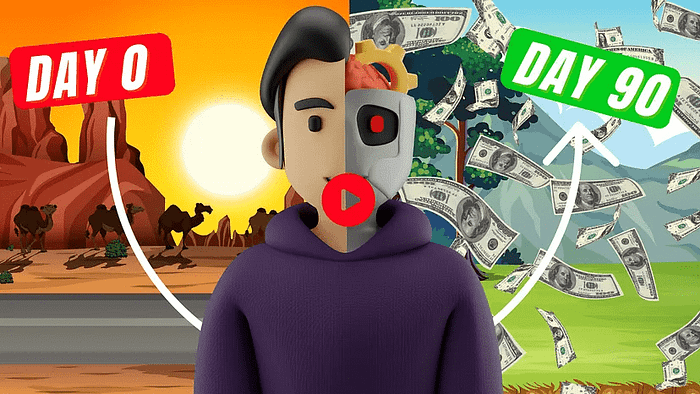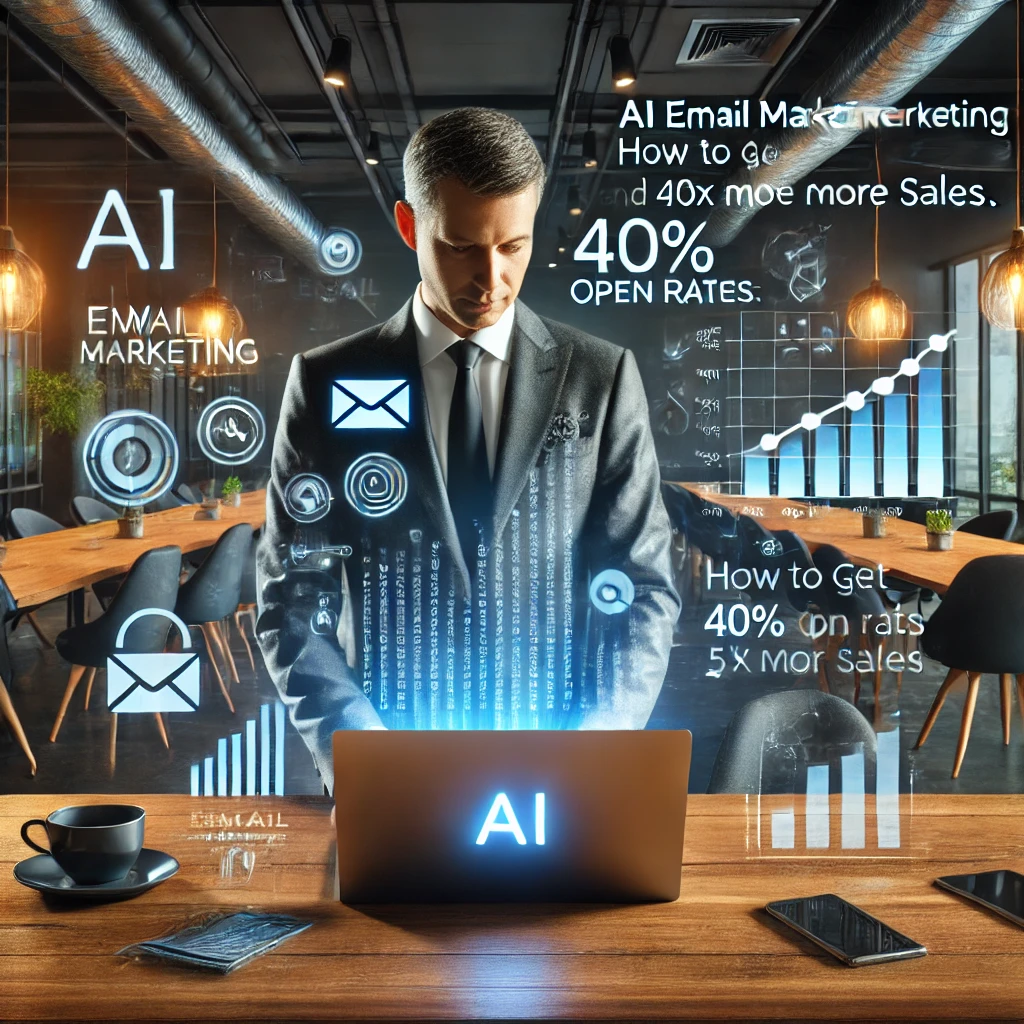AI Email Marketing: How to Get 40% Open Rates and 5X More Sales
Introduction: The Power of AI Email Marketing
Ever wondered about a clever method to make nearly every cold outreach message get opened? I’m here to share a game-changing secret about AI email marketing: 40% open rates are within reach when you mix smart tools with an old-school twist. I recently watched someone reveal a tactic so effective that even busy Fortune 500 CEOs can’t ignore it. It’s not just about sending emails—it’s about standing out in a crowded inbox. This approach uses three key ideas to grab attention and spark action. Let me walk you through what I learned, step by step, as I observed this brilliant strategy unfold. It’s a mix of creativity, technology, and human psychology that can transform your outreach. Ready to see how it’s done?
We strongly recommend that you check out our guide on how to take advantage of AI in today’s passive income economy.
Table of Contents
Why This Method Works: The Three Key Factors
I saw someone break down the reasons cold outreach fails or succeeds into three clear pieces. First, there’s volume—the sheer number of messages someone gets daily on a platform. For instance, a marketing agency owner might get hundreds of cold emails weekly, making it tough to stand out. If you message them on a crowded channel like LinkedIn or email, your note might get lost. But choosing a less noisy platform, like Instagram, can make them more likely to respond. The platform matters because it changes how buried your message gets. Volume works against you when it’s high, drowning your efforts. Understanding this inverse relationship is key to cracking higher open rates.
Next comes personalization, which I noticed plays a huge role in human behavior. When a message feels tailored just for the recipient, they naturally want to peek inside and reply. The challenge is making it truly feel personal, especially with AI personalization tools flooding the market. Generic attempts—like a screenshot of someone’s YouTube channel or a video with their website in the background—can seem sneaky and erode trust. Instead, taking time to research and craft a unique message by hand can push reply rates toward 50%. It’s about showing genuine effort, not just relying on AI-powered newsletters to fake it. People can sense the difference, and it matters.
The third factor I observed was curiosity, a powerful driver of human action. Unique and original tactics can spark interest, but only if they’re fresh. If a lead spots the same trick repeatedly, it loses its magic and can even damage credibility. For example, a tired tactic might get ignored after the third time, making the recipient question your authenticity. The person I watched explained how open rates rise as volume drops and personalization grows. It’s a balance that sounds simple but takes creativity to execute. Curiosity, when done right, pulls people in like a magnet. This trio—volume, personalization, curiosity—sets the stage for what’s next.
The Secret Tool: Handwritten Letters in a Digital Age
I was intrigued when the strategy shifted to a surprising channel: physical mail. Consider a busy business owner who’s just cleared their inbox, deleting dozens of cold emails. Their office manager walks in with six envelopes—four are obvious ads from credit card companies, one’s a coupon from Office Depot. But the sixth stands out: a thick, heavy envelope with a real stamp, hand-addressed in pen with their name and address. It’s not junk mail; it looks personal. Would they toss it with the rest? Most wouldn’t—they’d open it. This tactile, unexpected approach cuts through digital noise like a knife.
What I learned next was a $10 million secret: using AI email automation to trigger handwritten letters. The person I observed used tools like ChatGPT, Zapier, and a website called Handwritten (spelled with a “y”) to automate this process. They weren’t sponsored—just genuinely impressed by its effectiveness. These letters warm up qualified leads, close deals, and even reach Fortune 500 CEOs. The setup involves AI crafting a message, Zapier handling the automation, and Handwritten physically writing and mailing the letter. It’s a blend of AI lead generation and old-school charm. The result? A letter that feels personal and demands attention. I’ll break down how they set it up soon.
Digging into Handwritten: The Tool That Makes It Happen
The person I watched pulled up Handwritten’s website to show how it works. Each letter costs around $4, but bulk plans can drop it to $3.25—affordable for targeting hot leads. The letters are high-quality, written with real ink by a machine mimicking human handwriting, complete with a stamp and envelope. They shared an example: a returned letter addressed in pen, looking like a personal note from a friend. It’s not just paper—it’s an experience that screams “open me.” The pricing makes sense for high-value outreach, especially when a single deal can cover the cost. For instance, sending these to leads who haven’t closed can nudge them over the line. It’s a small investment for a big payoff.
What makes Handwritten powerful is its integration with Zapier for automation. After signing up, you create templates—like designing a postcard’s back, while the front gets the handwritten message. The person I observed stressed the importance of these templates being ready to go. They used this for multiple purposes: warming up leads, cold outreach to high-value targets, and nurturing existing customers. It’s not just about AI sales conversion; it’s about building trust through tangible touchpoints. The letters look so real that recipients can’t help but engage. Automation makes it scalable, but the human-like feel keeps it effective.
Setting Up the Automation: A Step-by-Step Look
I watched as they dove into the nitty-gritty of setting up the automation in Zapier. It starts with a trigger—like a lead filling out a form or a salesperson noting a hot prospect. The more info you have on the recipient, the better the personalization. For example, after a course intake form, the automation pulls details like goals and challenges to craft a custom letter. ChatGPT steps in to write a heartfelt note, following strict rules: five sentences max, simple language, no signature, and a friendly tone. The prompt ensures the message aligns with the recipient’s stated goals, tying it to the course’s benefits. It’s AI personalization done right—not robotic, but relatable.
The automation splits into paths for USA and international addresses to avoid wasting money on undeliverable mail. For USA leads, they use a tool called Lob to validate addresses, ensuring the letter only goes out if it’s deliverable. Handwritten then takes over, using the validated address and a chosen template—like an “Insiders Welcome” design. You can even pick a handwriting style to match the sender’s vibe, like a more executive look for a CEO. The ChatGPT message gets inserted, complete with a sign-off, and optional extras like gift cards or QR codes can be added for lead generation. It’s a seamless blend of AI email automation and physical delivery. Every detail is thought out to maximize impact.
Use Cases: From Hot Leads to Fortune 500 CEOs
I saw three main ways this tactic gets used, each with a clear purpose. First, for hot leads—people who’ve already had a sales call and shown interest. A handwritten letter can push them to sign up by keeping you top of mind. The personal touch builds trust, making them feel valued. Second, for high-value cold outreach, like targeting Fortune 500 CEOs. These folks get tons of emails but often open their physical mail, especially if it looks personal. A $3.25 letter can lead to a massive deal if your offer resonates. It’s a gamble worth taking for big fish.
The third use case is nurturing existing customers or new team members. Sending a thank-you letter after a purchase or onboarding makes people feel appreciated. For example, a “welcome” note to a new client with a personalized message can kick off the relationship on a strong note. It’s not just about AI-powered newsletters; it’s about creating memorable moments. The person I observed even sends swag—like headbands or polos—to program members, adding a fun twist. These small gestures turn one-time buyers into loyal fans. It’s a strategy that blends automation with genuine care.
Fine-Tuning the Process: Avoiding Pitfalls
One thing I noticed was their caution around invalid addresses, especially internationally. They use ChatGPT to parse tricky details like cities or provinces, then verify with Lob before sending. This cuts down on returned letters—though some still slip through, as they showed with a “Return to Sender” example. They also recommended checking the AI-generated message before it’s sent. Early on, they’d get an email preview to ensure the letter didn’t sound robotic or irrelevant. It’s a safeguard against AI personalization gone wrong. You don’t want a lead getting a card that screams “bot.” Precision here keeps the strategy effective.
For cold outreach to big players like Fortune 500 CEOs, they advised starting with a cold email campaign first. Only send letters to those who click or reply—saving money and targeting engaged leads. If you’re going all-in, enrich data with tools like Apollo, then use ChatGPT to craft a tailored letter. Adding inserts—like a business card or QR code—can drive action, pulling them into your system. It’s a calculated mix of AI lead generation and human connection. The key is ensuring the offer inside matches the effort of the delivery. A great letter with a weak pitch won’t close the deal.
The Results: Why It Works So Well
The person I watched promised that nearly 100% of recipients open these letters. It’s on you to make the content compelling enough to spark action. They opened one to show me: a thick envelope with a sleek design on the back, the inside message written in neat, human-like script. It thanked a recipient named Sheldon for joining a course, tying his goals to the course’s benefits in simple, friendly language. It even suggested he hang up the note as a reminder—a clever nudge. The letter felt hyper-personalized, like a friend reaching out. It’s a stark contrast to generic emails that get trashed.
This approach combines the best of AI email marketing—40% open rates and beyond—with a tangible twist that feels authentic. It’s not just about open rates; it’s about building trust and driving sales. They claimed it can 5X your results if paired with a solid offer. I could see why: it cuts through the digital clutter in a way email alone can’t. The tactile experience of opening a real letter engages senses that screens don’t. It’s a reminder of how powerful blending old and new can be. For anyone struggling with outreach, this could be a game-changer.
Final Thoughts: Taking Your Outreach to the Next Level
Reflecting on what I observed, this strategy is a goldmine for anyone serious about AI email marketing: 40% open rates are just the start. It’s tactical, practical, and can drive real revenue. The person I watched runs a program with templates and automations you can copy—proof it works for them and their students. If you’re into cold outreach, this blends AI sales conversion with human psychology in a way that’s hard to ignore. It’s not just about sending letters; it’s about crafting experiences that stick. Want to learn more? Dig into cold email strategies and see how this fits. It’s a fresh angle that can set you apart.

We strongly recommend that you check out our guide on how to take advantage of AI in today’s passive income economy.




